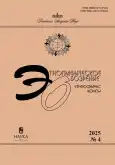Irish Dance in the Modern World: Setting of Pub, Competition, and Stage
- Autores: Glazovskaya A.A.1
-
Afiliações:
- independent researcher
- Edição: Nº 4 (2025)
- Páginas: 57-73
- Seção: Special Theme of the Issue: Ethnography of Performing Arts (guest editor S.I. Ryzhakova)
- URL: https://stomuniver.ru/0869-5415/article/view/697015
- DOI: https://doi.org/10.31857/S0869541525040052
- ID: 697015
Citar
Texto integral
Resumo
Ireland’s image in mass culture is closely associated with Irish dances, which are one of the country’s distinctive symbols. As a result of the success of the touring dance show “Riverdance” in 1994, Irish dances have long ceased to be considered to be only “Irish”. The Irish Dance World Championships are attended by over 6,000 dancers from around 30 countries. Riverdance still remains one of Ireland’s most profitable export products. The dance form that we see today on the stage, associated with Ireland, was developed at the beginning of the 20th century. This was a result of the country's quest for independence. Since then, however, its functions have changed in the modern world. When this dance became widely known on the global stage during a period of economic boom (the effect referred to as the Celtic Tiger), it became a reflection of global “western” trends that were completely opposed to established notions of how the dance should be performed: “past, catholic, rural” has been modified into a Broadway-style performance. This article investigates how a local cultural phenomenon, which is considered “folk dance” on stage, became an object of commodification in the 21st century, as well as the changes it has undergone (and continues to undergo).
Palavras-chave
Sobre autores
A. Glazovskaya
independent researcher
Autor responsável pela correspondência
Email: a.glazovskaya@icloud.com
ORCID ID: 0000-0002-9823-5160
Moscow, Russia
Bibliografia
- Абашин C., Бредникова О. (ред.) 2021. Жить в двух мирах: переосмысляя транснационализм и транслокальность. М.: НЛО.
- Нарский И. Как партия народ танцевать учила, как балетмейстеры ей помогали, и что из этого вышло. М.: НЛО, 2018.
Arquivos suplementares










